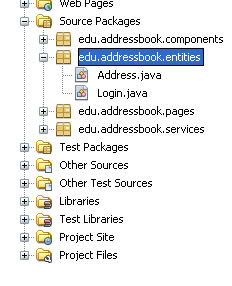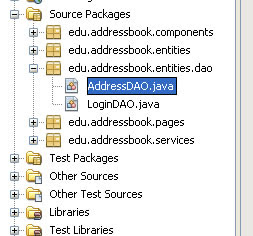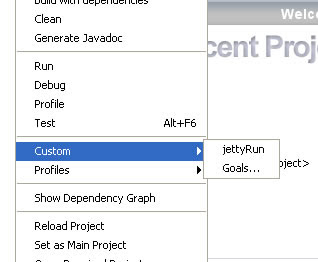- BeanEditForm - Generates a simple UI for editing the properties of a JavaBean, with the flavor of UI for each property (text field, checkbox, drop down list) determined from the property type (or by other means, such as an annotation), and the order and validation for the properties determined from annotations on the property's getter and setter methods.
- Grid - A grid presents tabular data. It is a composite component, created in terms of several sub-components. The sub-components are statically wired to the Grid, as it provides access to the data and other models that they need. A Grid may operate inside a form.
package edu.addressbook.pages;
import java.util.Date;
import org.apache.tapestry5.annotations.InjectPage;
/**
* Start page of application AddressBook.
*/
public class Index {
public Date getCurrentTime() {
return new Date();
}
}
<html t:type="layout" title="AddressBook Index"
t:sidebarTitle="Current Time"
xmlns:t="http://tapestry.apache.org/schema/tapestry_5_1_0.xsd"
xmlns:p="tapestry:parameter">
<!-- Most of the page content, including <head>, <body>, etc. tags, comes from Layout.tml -->
<p>${message:greeting}</p>
<h1>List of Contacts</h1>
<t:grid source="addresses" row="address">
</t:grid>
<p>
<t:pagelink page="another">Add Contact</t:pagelink>
</p>
<p:sidebar>
<p>
Just to prove this is live:
</p>
<p>The current time is: ${currentTime}.</p>
<p>
[<t:pagelink page="Index">refresh</t:pagelink>]
</p>
</p:sidebar>
</html>
package edu.addressbook.pages;
import edu.addressbook.entities.Address;
import edu.addressbook.entities.dao.AddressDAO;
import java.util.Date;
import java.util.List;
import org.apache.tapestry5.ioc.annotations.Inject;
/**
* Start page of application AddressBook.
*/
public class Index {
@Inject
private AddressDAO addressDAO;
private Address address;
public Address getAddress() {
return address;
}
public void setAddress(Address address) {
this.address = address;
}
public List<Address> getAddresses(){
return addressDAO.retrieveAll();
}
public Date getCurrentTime() {
return new Date();
}
}
<html t:type="layout" title="Another"
t:sidebarTitle="Current Time"
xmlns:t="http://tapestry.apache.org/schema/tapestry_5_1_0.xsd"
xmlns:p="tapestry:parameter">
<!-- Most of the page content, including <head>, <body>, etc. tags, comes from Layout.tml -->
<h1>Create New Address</h1>
<t:BeanEditForm t:id="address" />
<p:sidebar>
</p:sidebar>
</html>
/*
* To change this template, choose Tools | Templates
* and open the template in the editor.
*/
package edu.addressbook.pages;
import edu.addressbook.entities.Address;
import edu.addressbook.entities.dao.AddressDAO;
import org.apache.tapestry5.ioc.annotations.Inject;
/**
*
* @author killertilapia
*/
public class Another {
private Address address;
@Inject
private AddressDAO addressDAO;
public Address getAddress() {
return address;
}
public void setAddress(Address address) {
this.address = address;
}
Object onSuccess(){
addressDAO.add(address);
return Index.class;
}
}
And you should have also noticed that the grid component of ours spills out of the page. It just has too many fields to display. You can exclude that to look like this:
<h1>List of Contacts</h1>
<t:grid source="addresses" row="address" exclude="address1,address2, middlename,landphone">
</t:grid>
Get the latest code from the repository. And remember happy weaving.






















